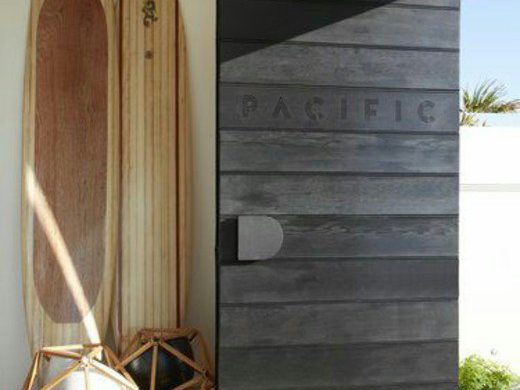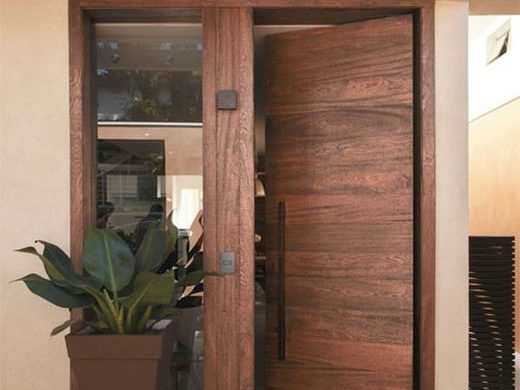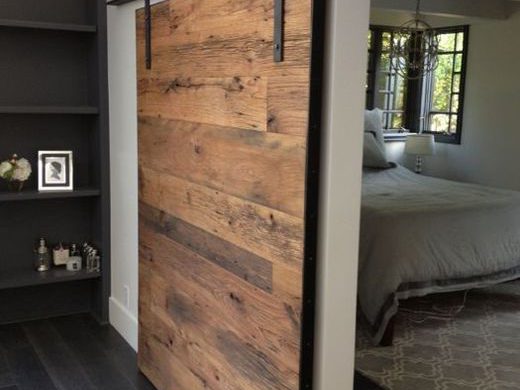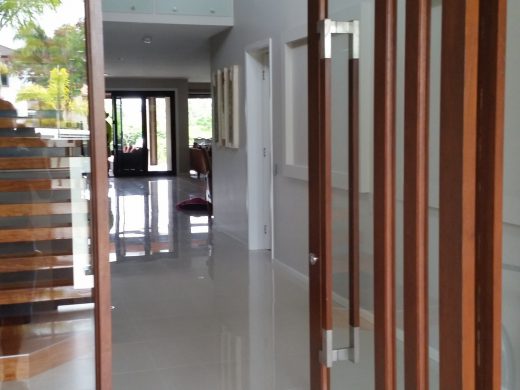Introduction
This guide provides advice and important information that will help keep your Affordable door looking beautiful and working for many years, while maintaining warranty coverage. Regular inspections and minor maintenance are the best ways to keep your doors in good condition.
Do I need to paint, stain or seal my door?
- Yes, all Affordable Doors are supplied unfinished and need to be finished - painted, stained or otherwise sealed.
- Timber is a natural product that is greatly affected by changes in moisture. This change in moisture will cause the timber to warp, crack or in some cases rot. Unprotected timber can physically deteriorate if exposed to extremes of atmospheric change over a period of time.
- Therefore, all timber products should be painted, stained, or otherwise sealed before being installed to help protect them from changes in moisture – regardless of whether they are being used inside or outside.
Which parts of the door should I finish?
- All six surfaces - two faces and four edges - of the door should be painted immediately after fitting and before hanging - this includes behind the hinges, and lock and most importantly, you should always paint the top and bottom edges
How many coats of paint/stain should I give the door?
- Always follow the paint manufacturer’s instructions on the number of coats required.
- The top, bottom and sides of the door need to receive the same number of coats as the faces.
- Tests have shown that doors with the correct number of coats of paint or finish (as per paint manufacturers recommendations) outlast and perform better than those not finished adequately.
Should I sand my door before finishing?
- Generally paint manufacturers will specify that you should give timber a light sand before finishing. Always refer to the paint manufacturer’s advice.
- The surface should be prepared with appropriate sand paper. Under no circumstances should you use steel wool or other metal scourers.
How much should I sand a veneer door?
- Light sanding is recommended on veneer doors. Do not sand veneers back more than 0.2mm as the substrate may be exposed. Do not use sandpaper with a grit value lower than 240. Always sand in the direction of the grain.
What type of paint/stain should I use?
- Always use good quality paint or coating systems and follow the paint manufacturer’s advice.
- Be sure to pay particular attention to ‘internal’ vs ‘external’ paint systems and use one that is appropriate to where you are hanging the door.
- Never use automotive or two pack paints on doors.
- For best results on timber veneer doors used in external applications, we recommend using Feast Watson Weatherproof Satin.
What colour can I paint/stain my doors?
- Doors exposed to sunlight should be painted with light reflective colours as dark colours absorb light and heat. Using dark colours will cause a drying effect on the doors and could cause the doors to warp. The use of a light coloured topcoat is recommended.
- Your paint supplier or manufacturer can advise you on the light reflectance value (LRV) of the colour you have selected – the higher the light reflectance value, the less heat the substrate will absorb and the longer the life expectancy of the paint finish.
How do you classify light and dark colours?
- Black has a light reflectance value (LRV) of approximately 5. White has an LRV of approximately 95.
- Choosing paint colours with an LRV of greater than 50 is a wise choice for doors exposed to sunlight.
- Your paint manufacturer should be able to advise you of the LRV for a selected colour.
Can I paint my exterior doors different colours on the inside and outside faces?
- No, using different colours on the exterior and interior will cause uneven heat / moisture absorption, particularly for doors in exposed locations. The finishing paint or stain should be the same colour on all six sides. Using different colours may cause the door to warp.
Can I paint my door in high gloss paints?
- Honeycomb doors with a 3.2mm skin should be painted with flat, semi gloss or satin finishes.
- Honeycomb doors with 4.75mm or thicker skins can be painted with gloss or high gloss paints.
- We do not recommend painting Blokdor core doors with gloss finishes.
Is it normal to see variations in colour and texture with timber doors?
- Yes, timber veneers can have significant variation in colour and grain patterns and textures. These variations in colour and grain are unavoidable and are part of the natural beauty of timber; they are not considered defects.
What should I do with my door once I’ve received it?
- Always store your door in a dry covered building, not in wet, exposed or freshly plastered areas where moisture can get to the door. Your door should be stored off the ground/floor.
Do I need an awning on an external door?
- Yes, entrance doors must be installed in weather protected openings to reduce the effects of weather exposure. The Affordable warranty will not cover doors that are fully exposed to the weather.
- You should avoid getting doors wet, even after finishing.
How do I wash my door?
- Wipe your front door down with a damp cloth. Do not use harsh chemicals or detergents on your door.
- Never hose your front door down or get your door wet.
Which way do I hang my door?
- Hang stile and rail/joinery doors with the beads facing externally. Always hang doors as directed by the label on the door.
What sort of door furniture can I use?
- Always use a good quality door furniture supplier. Make sure your door furniture is appropriate for entry or internal applications. Always follow the door furniture manufacturer’s advice for installation and fitting.
Where do I put the door furniture and hardware?
- Always understand the construction of your door before attempting to fit it with furniture or hardware. The utility or structural strength must not be impaired in the fitting of the door, the application of hardware or cutting and altering the door for lights, louvres, panels or any other special details. Always follow the door furniture manufacturer’s advice for installation and fitting.
What is a lock block and why is it important?
- A lock block is a piece of timber fixed inside the door.
- Hollow Core doors (such as Honeycomb construction and Coritech construction) contain a lock block. As the construction is not 100% solid timber, a lock block is required to keep the handle and door furniture in place.
- It is extremely important that the position of the lock block is located before checking out of the hinges, hanging the door or fixing the door furniture.
How do I tell where the lock block is positioned?
- To help indicate which side of the door the lock block is positioned, a lock block label is located on that side. This label is always on the spine/stile.
- The lock block is positioned 1020mm from the bottom of the door. With moulded panel doors (such as the Stanford) lock blocks are fitted in the centre of the chair rail.
What size is the lock block?
- The lock block will cover door furniture back set up to 60mm. An internal door lock block is 410mm in height for 2040mm high doors; an external door lock block is 500mm in height.
How much can I trim off my door?
- Internal doors - 5mm off top and bottom rails; 5mm off each stile
- Joinery doors - 5mm off top and bottom rails; 5mm off each stile
- External routered doors - 5mm off top rail; 5mm off each stile; 25mm off bottom rail
- External flush panel doors - 5 mm off top and bottom rails; 5mm off each stile
Do I need to do anything after I’ve hung my door?
- Yes, we recommend that you regularly inspect your door for any paint breakdown. Pay special attention to possible paint breakdown around glass openings and joints. Once the paint system has begun to break down, you should re-finish your door.
Your Door has been handcrafted to last for years to come. But, like any fine piece of furniture, its finish will require some simple, periodic maintenance to keep it looking great and provide proper protection against the elements. Regular finish maintenance is also a requirement of the warranty that’s included with every door.
Signs to watch for
They indicate that its time for some simple, easy-to-perform maintenance:
- Hairline cracks in the top coat of finish.
- Changes in the color of the finish.
- Changes in the texture of the finish, such as flaking or scaling.
- Dullness or chalkiness in the finish.
If you live in severe climate or your entry receives a lot of direct sunlight or weather exposure from any direction, you’ll want to examine your door’s finish often. Depending on the conditions, you may also need to maintain the door finish more frequently.
It is important to note that wood has inherent dynamic qualities. Over time, small surface “imperfections” may appear, and the door may shrink or swell slightly as it “breathes” with climate changes. These characteristics are perfectly normal, reflecting the natural aging process of a wood door, and they should not be considered defects. To minimize these occurences, protect your door with the right finish and an adequate overhang, meaning the entry doesn’t receive any rain or sun at anytime of the day. Otherwise the Door Warranty is Void.
What is ‘show through’?
- Show through is when the internal construction of the door has left a slight impression on the skin of the door. When this happens it will generally be doors with a 3.2mm MDF skin. Normally show through is only seen at certain angles or when high gloss paints are used. Show through of frame and core components is not considered a defect.
What is warp?
- Warp means the cupping or twisting of timber. When it comes to doors, it refers to the distortion within the door itself and not its relationship to jambs or the frame in which it is hung.
- Warp not exceeding 5mm on doors up to 2135 x 915 x 35mm, or 6mm on doors over 2135 x 915 x 35mm and up to 2440 x 1200 x 35mm will not be considered a defect.
- You can determine cupping by applying a straight-edge to the concave face of the door, or twist by placing the door face against a true plane surface.
What causes warp?
- Warp can be caused by a number of factors, but generally warp is caused by improper storage or adverse moisture conditions. Using dark or varying paint colours can also cause the door to warp.
Is warp covered by the warranty?
- It is the responsibility of the installer and homeowner to ensure that the finishing advice in this document has been adhered to. Failure to follow any of these instructions will void the warranty. Affordable does not accept responsibility for warp when the moisture content of the timber falls below 10% or exceeds 14%.
- If excessive warping occurs, seek advice promptly to help solve the problem.




